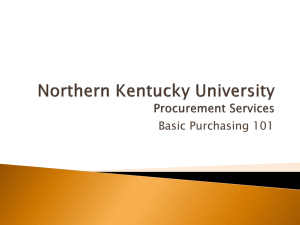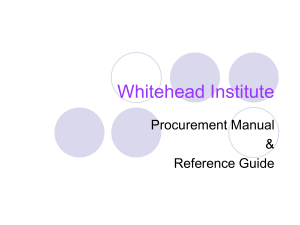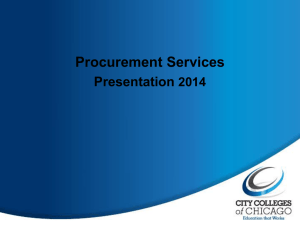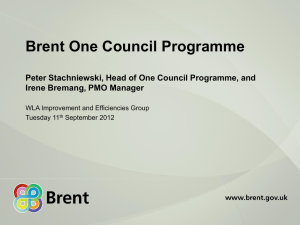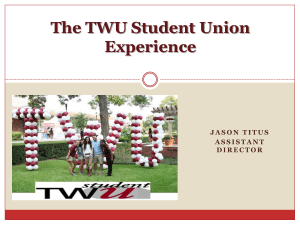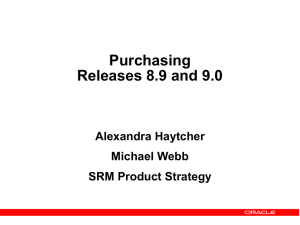Students First
advertisement
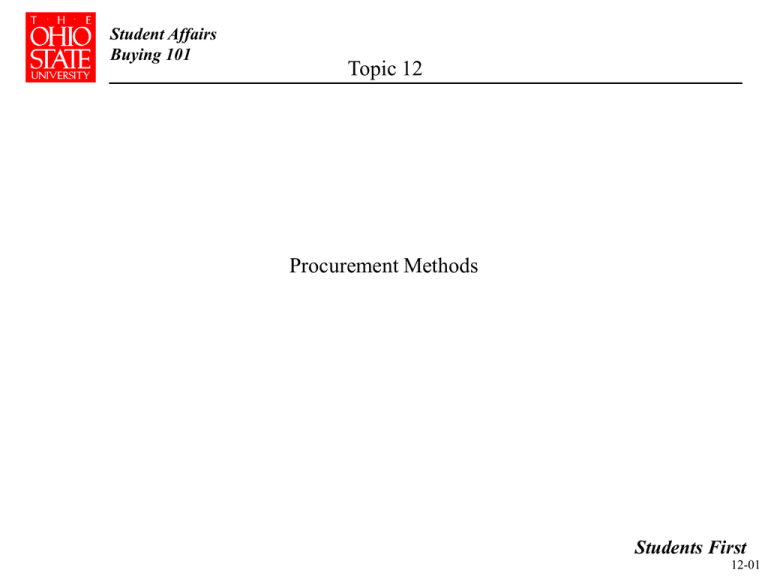
Student Affairs Buying 101 Topic 12 Procurement Methods Students First 12-01 Student Affairs Buying 101 Procurement Methods Topic Objectives • Have a general understanding of the 5 primary ways to obtain goods and services • For each, have a general understanding of the timelines, advantages, and disadvantages Students First 12-02 Student Affairs Buying 101 Procurement Methods The previous slides primarily focused on Procurement considerations, but what procurement methods are available? The primary means to obtain goods and services are as follows: Requisitions/Purchase orders Non-purchase orders (FAS-12) Procurement cards Internal orders (100Ws) Petty cash reimbursements However, for each of these processes, the basic steps are generally the same. Students First 12-03 Student Affairs Buying 101 Procurement Methods Purchase Order – A purchase order is the offer of a contract between the University and an offcampus vendor for the purchase of goods/services. • Delegated buyers need to confirm that the cost of goods/services is within the allowable buying limit of $5,000. • After the delegated buyer creates the PO, the status of the PO will remain at “Pending Approval” until it is reviewed for compliance to the University Expenditure Policies and departmental policies. • If the cost of goods/services is over $5,000, an on-line requisition should be created. Timeline –If over $5,000, once the requisition has been approved by the Business Office, you should expect the purchase order within 3 to 5 working days if everything is OK. If purchase exceeds bid limits, expect 3 to 5 weeks to go through the bid process. Advantages – with a purchase order you have a contract with the vendor to deliver goods and/or services at a specified time and amount. Vendor sends itemized invoice to be approved before payment is issued. MBE is tracked. Able to take advantage of discounts from vendors as arranged per contracts. Disadvantages – may take a little more time if additional approvals are needed. Students First 12-05 Student Affairs Buying 101 Procurement Methods Blanket Purchase Order – A blanket purchase order is a type of purchase order. A blanket purchase order is generally issued to a vendor for miscellaneous items, that are not specifically listed on the purchase order. Typically, a blanket purchase order does not specify a delivery time period or prices, and is generally open for one year. A blanket purchase order establishes a line-ofcredit with the vendor and the originating department. Example: A department may issue a blanket purchase order to a vendor for miscellaneous office supplies. Then as the office supplies are needed, the department contacts the vendor and places a phone order. Timeline – (Same as a purchase order). Typically entered into PeopleSoft in June for the following fiscal year. Advantages – Separate POs are not needed for each time items are requested. Vendor sends itemized invoice to be approved before payment is issued. MBE is tracked. Disadvantages – no lock-in on prices. Fiscal reports recognize the PO amount as an encumbrance which may create incorrect budget remaining balances. Only one blanket order can be issued per vendor, per organization and fund each year. Students First 12-06 Student Affairs Buying 101 Procurement Methods Non-PO Voucher (FAS-12) – The non-po voucher is a paper form that designates the items that can be purchased without the creation of a requisition or purchase order. (See list of allowable expenses for Non-PO Vouchers in Appendix M, page 4). • If the goods/services being purchased are on the approved list (see Non-PO Voucher List included in your materials) and within any specified limit (see list), proceed with submitting the invoice or FAS12 directly to Student Affairs Business Office satellite Accounts Payable. Please note – the Web FAS12 is not longer available for use by Student Affairs units due to compliance changes in the University Expenditure Policies (effective 6-06). Timeline – payment can be made after appropriate paperwork is complete and approved usually within a week (assuming vendor is already setup in the payables system). Advantages – no need for purchase order. Payment processing is faster. Disadvantages – no MBE tracking, restricted use, and information is not included in buying/tracking reports. Students First 12-07 Student Affairs Buying 101 Procurement Methods Procurement Card – purchases made with the Pcard provide faster payment to the vendor. Eliminates use of an employee’s own funds. Must uphold our tax-exempt status. • Does the vendor selected accept the University’s Procurement Card? • Is the cost of the goods within the allowable limits of your Procurement Card? Timeline – immediate ability to purchase goods. Advantages – billing is automatic through bank and OSU. Disadvantages – Purchasing cards have no dispute rights for fraudulent charges. If the card or card number are lost or stolen, the bank can charge the department up to $5,000 (or maximum card limit). No MBE, card dollar limitations, more restricted commodities, and no contract with vendor that goods will work properly. Always make sure that vendor is not charging sales tax. Cannot use Pcard for purchasing services. Not able to take advantage of vendor discounts that may be provided by established university contracts (purchase Students First orders). 12-08 Student Affairs Buying 101 Procurement Methods Internal Orders (100Ws) - (internal OSU vendors) – Using the 100W form is a practical and easy method of procuring goods and services within the University. Required Controls: • validate that a complete chartfield appears • validate a departmental approver signature appears on the 100W • require a receipt signature for all goods and/or services provided to initiating department personnel • must maintain security over 100W forms (treat as signed checks) and log to track use. Timeline – purchase of goods or services is immediate Advantages – internal billing – less paperwork Disadvantages – no MBE tracking. Note – no longer are departments permitted to accept an accounting chartfield in place of a 100W. Stores is now beginning to require Requisitions and not 100Ws. Students First 12-09 Student Affairs Buying 101 Procurement Methods Petty Cash Reimbursements – A reimbursement is the paying back of money to a staff member that has been spent on behalf of the University. Reimbursements differ from refunds in that a refund is the paying back of money that has been paid to the University. • No employee may approve his or her own reimbursement request. The approving authority must hold a higher University rank than the person being reimbursed. • When possible, efforts should be taken to avoid making University related purchases using an employee’s personal funds. Timeline – purchase of goods or services in immediate. Advantages – provides quick and easy way to procure items. Disadvantages – no MBE tracking and fewer controls. Employee fronts funds. Maximum reimbursement amount is $50.00 and using Petty Cash for services is prohibited. Considerable paperwork and time required to reimburse petty cash fund. Students First 12-10 Student Affairs Buying 101 Procurement Methods How are the processes generally the same? For each you should: • • • • • • • • • • • Plan, identify, and document the need and get approval Ensure adequate funds and proper chartfield Identify the provider of the goods and services Establish the contract (e.g., use of a Pcard is an agreement that we will pay for the goods) Receive the goods or services Receive the invoice (e.g., statement from bank that OSU pays for Pcard expenses) Match invoice with the purchase order/receipts/receiving documents Request payment Pay the vendor Reconcile transactions and supporting documentation to the general ledger Regardless of the purchasing or payment method, all documentation must be the same; • Document business purpose • Service or delivery dates • Itemized expenses • File and retain the documentation in accordance with records retention guidelines Students First 12-11

